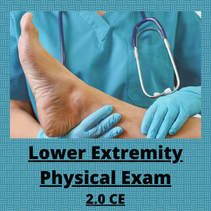Become a Member to access extra content. It's FREE! |
Become a Member to access more content - It's FREE!!!
Lower Extremity Physical Examination - 2.0CE Credits
Description
Lower Extremity Physical Examination
This video will allow you to be comfortable performing a physical examination of the legs and feet. Whether you are performing routine foot care or lower extremity wound care, this program is a must. Learn a sequenced examination of the four organ systems represented in the lower extremity; Vascular, Neurology, Musculoskeletal, Dermatology. A subjective exam plus non-invasive testing are covered in detail. After completing this program you will have the confidence you need to perform a general lower extremity exam and understand your findings. You will also earn 2.0 Nursing CEUs.
The Program:
1. General principles of a lower extremity examination
2. Dermatology Examination
Recognize common conditions: tinea, verruca, hyperkeratosis, porokeratosis
Toenail Pathology: pathologic nail discolorations (dark lines), onychomycosis, onycholysis, subungual hematoma, clubbed nails, Mee's lines
3. Musculoskeletal Examination
Joint examination: range of motion, strength, passive vs reactive
Common deformities: hammertoes, bunions, overlapping toes, metatarsalgia, hallux abducto valgus
4. Vascular Examination
Objective signs of Lower Extremity Vascular Disease
Non-invasive testing demonstrations: Doppler, ABI, TBI, temperature, capillary refill and pedal pulses
Common pathologies: stasis dermatitis, thrombophlebitis, pitting and non-pitting edema
5. Neurological Examination
Non-Invasive Testing: Semmes-Weinstein 10gm/5.07 Monofilament, DTRs, Vibration
Proprioception, fine touch
Motor, sensory & autonomic neuropathy
Objectives
After viewing this program, you will be better able to:
Describe physical changes to the skin that indicate long standing vascular insufficiency
List 3 skin conditions commonly found on the foot
Describe the progression (regrowth) of a nail after a subungual hematoma forms
List 3 musculoskeletal foot deformities
Name the 4 directions that the foot is moved at the ankle to test range of motion
.png)
Log in below: |
